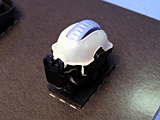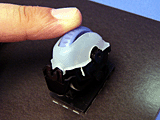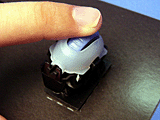There's an interesting article on The Failure and Future of Mobile Content in Brighthand by Ted Ladd, in which he describes four popular myths about why he thinks it's failed so far, and where it's going in the future - although as someone writing this article on a pda on a train, which I'll ftp via IRDA and a mobile phone using GSM/GPRS, I'm not entirely sure what he means by failure...
The "myths" are:
1. It's a technical problem
2. It's a management problem
3. It's an economics problem, or no cash post-crash
4. It's a bad experience
Now I'd argue with calling most of those myths, but the second half of the article is more interesting. Here he discusses the future of mobile content and describes four generations of mobile content
First generation: Same but smaller
Second generation: Alerts
Third generation: Exclusively mobile
Fourth generation: The Disappearance of Mobile Content
A breakdown of these generations is reasonably straightforward; the first generation was about trying to reproduce existing web information in a more managable format for smaller screens and limited input capabilities; the second is about using mobile devices as glorified pagers to alert people to content that could only easily be accessible from a desktop; the third is generating mobile specific information, things that are only really relevant to a mobile environment; and the fourth being where the difference between mobile and other environments has for the most part dissappeared.
Using this world view I guess the most that people are seeing is the third generation, either through niche applications that run on the mobile device or specialised content viewed on a web or wap browser. Although the majority of people are more likely to be stuck in the first generation doldrums of poorly implemented wap versions of existing sites.
What's going to help moving to the next generation?
A lot of these niche applications rely on data that's been scraped from other web pages or collated by search engines and the like. The big problem with this is that HTML is a lousy format to extract relevant data from, especially when so much HTML is invalid tag soup. Sure Google is God and all that, but pose it a slightly harder question like "which mobile network would give me the best coverage for where I live and work, and my journey to work?" and Google will flounder; One can do this sort of information searching with a web browser, but it's slow and tedious. There's coverage maps for many networks on the internet and even databases of cell towers, but the information is not available in a simple machine readable form.
One way that this conundrum might be resolved is to use proper semantic markup, XHTML and RDF for the content and CSS for the presentation layer.
Danny Ayers has an example of how this approach would be useful for complex queries
here, his example is "has anyone
Dan Brickley knows blogged about IM recently?" This is the sort of query that'd be possible to evaluate manually but a nightmare programatically unless one had decent semantic data to work with.
How can I help?
If you're a content provider (weblog, news provider, whatever), the first step is to serve up
valid HTML, if it's
hard to do that, you're probably doing things the wrong way anyway, and if you're only supporting one browser then you're certainly barking up the wrong tree. Next step, consider CSS, in this way you seperate your content from the presentation,
the CSS ZenGarden has a multitude of different stylesheets that demonstrate how effectively CSS based design can decouple your content from the layout. Next, metadata - webmonkey has a
good introductory article on metadata.
If you're just a user, you can still do plenty to aid the creation of better content, first off get a
better browser by which I don't mean Internet Explorer which
A. has
only had bugfixes since about version 4,
B.
Microsoft have ceased active development of and
C. has notoriously poor
CSS and standards support. Next, if you go to a website and it doesn't work with your browser, doesn't validate or would be improved with extra metadata, let the webmaster know, in the long run you're helping everyone that uses that site.
By
Jim Hughes



















